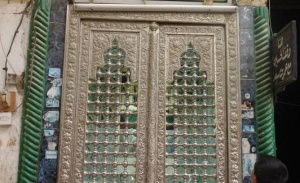Omar Ibn Sa’d
Omar Ibn Sa’d | |
|---|---|
| Native name | عمر بن سعد |
| Born | 1 H. (620 AD) Medinah |
| Died | 66 H. (686 AD) |
| Known for | killing Hussain ibn Ali in the Battle of Karbala |
| Spouse(s) | sister of Mukhtar al-Thaqafi |
| Children | Hafs Bin Amar ibn Sa'd |
| Parent(s) |
|
Omar Ibn Sa’d (d. Kufa 66/686), was the commander of the Umayyad troops at Karbala. He led an army of four thousand men at the battle of Karbala leading to martyrdom of Imam Hussain and his followers on 10 Muharram 61/10 October 680. It is said that his motivation for suppressing Imam Hussain revolt was to achieve the governorship of Ray. Finally, he was killed by the order of Mukhtar who revolted against Umayyad to take revenge of Imam Hussain’s martyrdom.
In the Battle of Karbala[edit | edit source]
Son of the famous Arab general Saʿd b. Abi Waqqas, he had just been made deputy-governor (naʾeb) of Ray by Obayd-Allah Ibn Ziad and was to go to Dastaba to quell a Daylamite rising when he was called back to check Hussain b. ʿAli’s insurrection. It was only under the threat of losing his post that he finally obeyed and marched at the head of 4,000 men, reaching Karbala on 3 Muharram 61/3 October 680. Although he cut off Hussain’s access to water, he tried to negotiate a settlement. At the urging of Shamer (known as Shimr by the Shiʿites) b. Dhu’l-Jawshan ʿAmeri, a former follower of ʿAli b. Abi Taleb, Ibn Ziad ordered Ibn Saʿd to attack Hussain immediately and threatened to give Shimr the command of the army. On the evening of 10 Muharram/10 October, Ibn Saʿd sent an ultimatum to Hussain through Abbas b. ʿAli (Tabari, II, pp. 308-20). The next morning Ibn Saʿd attacked, apparently hoping that Hussain and his followers would surrender, but the circumstances ended in massacre.
According to some accounts, Ibn Saʿd was reluctant to fight Hussain (Tabari, II, pp. 309-11), and his intervention probably saved the life of ʿAli b. Hussain Zayn-al-ʿAbedin. On the other hand, most traditions show him eager to obey Ibn Ziad’s orders. He thus had Hussain’s corpse trampled by ten horsemen (Tabari, II, pp. 365-68; Masʿudi, Moruj III, p. 259; cf. Balʿami, ed. Rowshan, p. 711, tr. Zotenberg, IV, p. 45). For his role in the tragedy of Karbala, Ibn Saʿd was executed in Dhul’-Hejja 66/July 686 by Ibrahim b. Ashtar, at Mukhtar’s orders, during the latter’s rebellion (Tabari, II, pp. 671-74; Hawting).
In Popular Culture[edit | edit source]
Although Turco-Persian literature of Karbala has elaborated on Ibn Saʿd’s villainy, many historical features of his character have been retained down to the most recent taʿziyas, such as his eagerness to keep his post in Ray and his reluctance to kill Hussain. In the Mukhtar-nama, Ibn Saʿd is cursed by his own wife, who is the sister of the Shiʿite rebel Mukhtar, and his severed head is cursed by his Shiʿite younger son (pp. 209-11; Kashefi, pp. 262 f.). An old tradition holds that Ray, the price paid to him for Hussain’s blood, was under a divine curse (Yaqut, Boldan, Beirut, III, p. 118; C. Barbier de Meynard, Dictionnaire géographique de la Perse, Paris, 1861, p. 278). Ibn Saʿd’s chastisement is sometimes shown as particularly horrible; in the story of Mohammad b. al-Hanafiya, Ibn Saʿd and Ibn Ziad are smeared with naphtha and set on fire (Calmard, p. 267). In Safavid Persia ʿOmar b. Saʿd was sometimes burnt in effigy in a ritual similar to the “killing of ʿOmar” (ʿOmarkoshan), perhaps because of a popular confusion with the caliph most hated by the Persian Shiʿites (Calmard, p. 500). In taʿziyas Ibn Saʿd is the only bad character who feels remorse for his own villainy; he is ashamed to have killed Hussain and protects ʿAli Zayn-al-ʿAbedin and the women of the Ahl-e Bayt, ordering them to be taken to Kufa in covered litters (mahamel mastura; Dinavari, ed. Guirgass, p. 270; Kashefi, pp. 349-50, 360). In some taʿziyas, he even seems opposed to the killing of Hussain (Mamnoun, pp. 67 ff.). But in spite of his hesitation and belated remorse, he remains a typical villain in the eyes of Muharram mourners. His arrogance while riding his horse and addressing himself to Hussain has become proverbial (methl-e Ibn-e Saʿd; ʿA.-A. Dehkhoda, Amthal o hekam, Tehran, 1352 Sh./1973, III, p. 1403).
Bibliography[edit | edit source]
- The main historical source is the narrative of Abū Meḵnaf (on him see U. Sezkin, Abū Mikhnaf, Leiden, 1971.), preserved most completely in Balāḏorī and Ṭabarī. On Arabic sources in general, see I. K. A. Howard, “Husain the Martyr. A Commentary on the Account of the Martyrdom in Arabic Sources,” Alserāt. The Imam Hussain Conference Number, London, 1986, pp. 124-42.
- L. F. Brakel, The Hikayat Muhammad Hanafiya. A Medieval Muslim-Malay Romance, doctoral dissert., Leiden, 1975.
- J. Calmard, Le Culte de l’Imām Ḥusayn. Étude sur la commémoration du drame de Karbalā dans l’Iran pré-safavide, Ph.D dissert., University of Paris III (Sorbonne), 1975.
- G. R. Hawting, “al-Mukhtār b. Abī ʿUbayd,” in EI ² VII, pp. 521-24.
- Hussain Wāʿeẓ Kāšefī, Rawżat al-šohadāʾ, ed. M. Ramażānī, Tehran, 1341 Š./1962.
- P. Mamnoum, Taʿzija. Schiʿitisch-persisches Passionspiel, Vienna, 1967.
- Moḵtār-nāma, Tehran, n.d.
- ʿA. Rafīʿī, “Ibn-e Saʿd” in DMBE III, pp. 682-83.
- L. V. Vaglieri, “Ḥusayn b. ʿAlī b. Abī Ṭālib” in EI ² III, pp. 607-15 (contains an extensive bibliography on the battle of Karbalāʾ).

